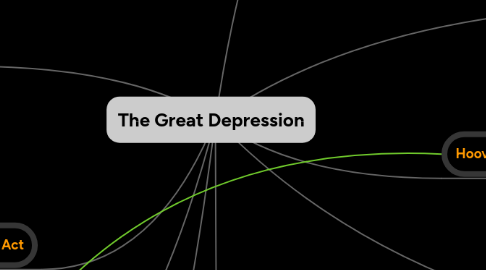
1. Americans react
1.1. Isolated protest movements
1.1.1. Dairy farms dump milk due to low price
1.1.2. Veterans march on Washington due to pension loss
1.1.3. 1932 Election
1.1.3.1. FRANKLIN DELANO ROOSEVELT(winner by landslide)
1.1.3.2. 1 out of 4 Americans unemployed
1.1.3.3. Nat'l income 50% than in 1929
2. NIRA and NRA
2.1. Fair labor codes is established
2.1.1. Wages
2.1.2. No Child Labor
2.1.3. Shortened Work Hours
2.2. Liberty league urged Supreme Ct. to overturn NIRA and NRA
2.2.1. Claimed federal gov. were exceeding authority
3. Agricultural Adjustment Act
3.1. Passed in 1933 to aid farmers
3.2. Food production down
3.3. In 1935, was declared unconstitutional
4. CIVILIAN CONSERVATION CORPS (CCC)
4.1. Established work for men 18-25
4.2. Blacks not permitted to enroll
5. Stock Market Crash
5.1. rapid buying and selling of stocks(Stock Speculation)
5.1.1. stock value increased
5.2. Buying on Margin
5.2.1. Investors only paid 10% of stocks actual value at time of purchase
5.3. Quick turnover didn't aid co.'s
5.3.1. Needed long term investments to pay bills
5.4. Inflated stock value
5.4.1. Gave false sense of security/confidence
6. Productivity/Unemployment
6.1. 1920's U.S. eco was based on
6.1.1. Productivity
6.1.2. Purchasing Power
6.1.3. Employment Cycle
6.2. Purchasing demand resulted in high employment
6.3. Over Production
6.4. Uneven dist. of wealth
6.4.1. 48% below poverty line
6.4.2. 58% middle class
7. Hoover's response
7.1. Government shouldn't play role in government
7.2. VOLUNTARY NON - COERCIVE COOPERATION- tax breaks for private sector investments
7.3. Euro. countries were to purchase U.S. goods
7.4. Banker's panic
8. Tariff Wars
8.1. Democrats passed high tariffs (Smoot Hawley)
8.2. Countries passed high tariffs (no foreign countries purchased U.S. products)
8.2.1. U.S. productivity decreased again
9. New Deal
9.1. STEP ONE:
9.1.1. Banking holiday- banks shut down for inspection
9.1.1.1. People's confidence returned
9.2. STEP TWO:
9.2.1. Stock market reform
9.2.1.1. Buying on margin was regulated
9.2.1.2. Security Exchange Commission
9.2.1.2.1. First chairman was Joseph P. Ken
9.3. STEP THREE:
9.3.1. Put more money in circulation
9.3.1.1. Wages and prices increased
